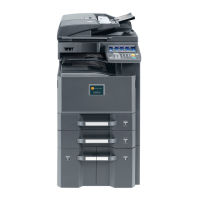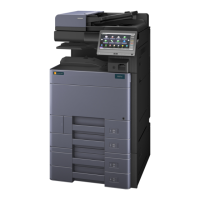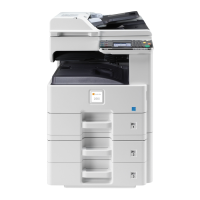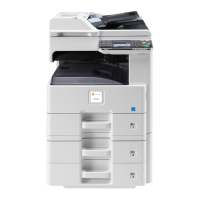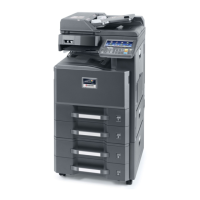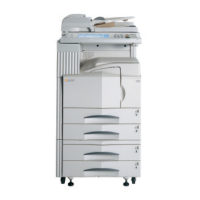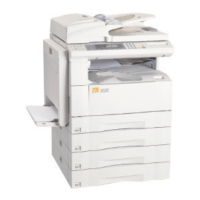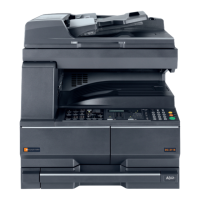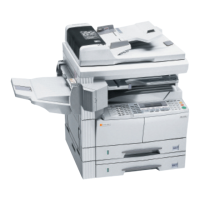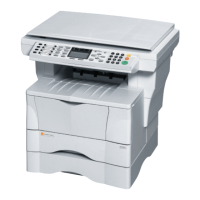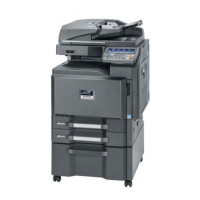Do you have a question about the Triumph Adler 2506ci and is the answer not in the manual?
Covers safety conventions, environment, and general precautions for machine usage.
Details copyright, trade names, and legal information regarding software and product usage.
Explains how the machine reduces power consumption when idle through Low Power Mode and Sleep Mode.
Identifies external components of the machine with labels and descriptions.
Provides instructions on how to turn the machine on and off safely.
Explains the keys and touch panel functions for machine operation.
Covers procedures for user login and logout, including default credentials.
Details configuring wired and wireless network connections.
Guides on installing printer drivers and utilities on Windows and Mac.
Provides instructions and precautions for loading various paper types into different trays.
Outlines steps for setting up a PC and shared folder for document scanning.
Explains how to add contacts and groups to the address book for sending functions.
Details various print settings available through the printer driver interface.
Explains how to register and print using custom paper sizes.
Describes how to cancel print jobs from the computer before printing begins.
Covers saving and printing jobs from various job boxes like Private Print and Stored Job.
Explains how to monitor printer status, job progress, and consumable levels.
Provides instructions for placing originals on the platen or in the document processor.
Explains how to register, recall, edit, and delete frequently used function settings.
Covers basic copy operations, proof copy, interrupt copy, and job cancellation.
Details methods for sending scanned documents via email, to folders, or FTP.
Explains how to select, confirm, and edit destinations for sending jobs.
Covers operations related to Custom Box, Job Box, and Removable Memory Box.
Explains how to print from and save to USB memory.
Details various functions available for copying, such as paper selection and finishing.
Covers settings for file format, FAX transmission, and sending options.
Explains settings for storing, printing, and sending documents in custom boxes.
Details settings for color selection and document naming when storing to removable memory.
Explains how to produce two-sided copies from one-sided or two-sided originals.
Describes printing original documents overlaid with a form or image.
Explains how to add page numbers to finished documents with various formats.
Covers setting a password to restrict access to PDF data.
Monitors the status of jobs being processed or waiting to be printed.
Displays detailed information for selected jobs.
Allows viewing and sending job history logs.
Covers pausing, resuming, canceling, and reordering jobs.
Checks the status of installed devices and network connections.
Checks the remaining levels of toner and paper.
Provides an overview of system menu settings for overall machine operation.
Configures paper size and media type for cassettes and the multi-purpose tray.
Configures overall machine operation settings like language and sound.
Configures settings related to originals and paper.
Selects whether to cancel or continue jobs when errors occur.
Specifies the output tray for different job types.
Sets default values for various functions like copying and sending.
Configures machine system and network settings.
Configures address book and one touch key settings.
Configures settings for user login and job accounting.
Configures settings related to date, time, and energy saving.
Adjusts printing quality and performs machine maintenance.
Configures internet-related settings.
Configures settings for installed applications.
Explains how user access is administered on the machine.
Enables user login administration, selecting authentication methods.
Registers, alters, and deletes users, and configures login administration settings.
Sets usage authority for each user via local authorization.
Sets machine usage restrictions by group registered in the authentication server.
Sets functions available for guest users who cannot log in.
Retrieves network user properties from the LDAP server.
Allows users to log in by simply selecting a user name.
Selects the authentication type when ID card authentication is enabled.
Enables PIN code authorization for network authentication.
Explains procedures for setting job accounting while using user login administration.
Explains how job accounting manages counts by assigning IDs to accounts.
Enables the job accounting function for the machine.
Configures access settings for job accounting.
Allows adding, changing, and deleting accounts with restrictions.
Sets default values for usage limits and counting by paper size.
Counts the number of pages printed, classified by job accounting type.
Prints total counts of relevant accounts as an accounting report.
Explains procedures for setting job accounting.
Specifies machine behavior when usage limits are reached.
Selects how copying and printing page counts are displayed (total or individual).
Specifies behavior for handling jobs with unknown user IDs.
Provides instructions for routine cleaning and part replacement.
Offers general guidelines for solving problems and implementing procedures.
Provides step-by-step instructions for removing jammed paper from various locations.
Instructs on how to clear staple jams in different finisher units.
Lists and describes available optional equipment for the machine.
Lists and describes optional applications for machine functionality expansion.
Explains how to enter characters using the on-display keyboard.
Explains paper sizes, types, and specifications for the paper source.
Provides detailed technical specifications for machine components and functions.
Defines technical terms and concepts used in the manual.
| Brand | Triumph Adler |
|---|---|
| Model | 2506ci |
| Category | All in One Printer |
| Language | English |
